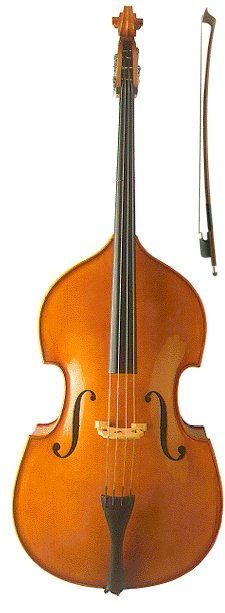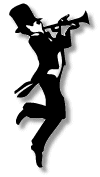Pay the Piper
The Double Bass
Family: String
Cost: from about £450
Best age to start: 11 years upwards
Easy to start? Yes
Easy to find a teacher? Not very
 The
double-bass is an instrument we would like to encourage: it's not very
difficult to start with, it's a very versatile instrument welcomed in
many different kinds of ensemble, and there are never enough
double-bass players around. Instruments have actually got cheaper
recently. It's also quite good fun to play!
The
double-bass is an instrument we would like to encourage: it's not very
difficult to start with, it's a very versatile instrument welcomed in
many different kinds of ensemble, and there are never enough
double-bass players around. Instruments have actually got cheaper
recently. It's also quite good fun to play!
The double-bass is a sort of giant violin, although actually it's
descended from an older form of instrument called the viol, which is
one reason why it has sloping shoulders instead to the very round
shoulders of the violin or 'cello (the other reason is that the
rounded shoulders would get in the way when you play it). It has four
thick steel strings tuned to E below the bass clef, then A, D and G.
The bow is short and heavy compared to a 'cello bow. As on the violin
you rub the rosined bow across the strings to make the sound, and
obtain different notes by stopping the strings against the fingerboard
with the fingers of your left hand.
Double bass music is written in the bass clef, like the left hand of
the piano. It is, technically, a "transposing instrument"
whose notes do not sound as they are written. In fact, the top open
string of the bass, written as G at the top of the bass clef, actually
sounds like the G an octave (eight notes) lower. In practice players
can ignore this, though, as notes an octave apart are pretty well
interchangeable in all music.
Some people play the bass standing up behind it or beside it, but
most teachers don't like this as it can lead to an awkward left hand
shape which will, in time, inhibit the fingering action. A good
alternative is to stand behind the bass with your left foot up on a
chair, but on the whole it is usually better to sit on a tall stool
with the instrument leaning between your legs. The stool is one thing
you should buy straight away. It needs to be tall - for an adult, a little higher than sitting on the corner of the kitchen table, for a child obviously a little lower. Ikea used to sell
a cheap adjustable stool called the "Ringo"
Bar Stool, but it seems to have been discontinued. Try searching Google for
"UK bar stool".
You also need something like a 'cellist's "mushroom" to
hold the spike at the bottom of the instrument, preventing it from
slipping and protecting the floor. A piece of wood with a little divot
in it for the spike, and a piece of string to tie it to the leg of the
stool, is cheaper.
Double basses can be obtained in different sizes. Most people start
on a 1/2 size (although there is a smaller "mini-bass"
available) which can be managed well by the average 12-year-old. A 3/4
size bass will last you the rest of your educational life, and in fact
some players never bother to move up to a full-size bass - these can
be very big indeed, and terribly unwieldy. You can start playing the
bass as soon as you are big enough, with the help of a small
instrument and a big stool, to reach the fingerboard comfortably. Many
young players start at 11 or 12, but there is also quite a tradition
of players coming to the bass fairly late, perhaps transferring from
another instrument when they realise that there are more opportunities
on the bass.
The double-bass is not a difficult instrument to start on, although
once you get up to Grade 4 or 5 and have to do a lot of "shifting"
(i.e. moving your whole left hand up and down the fingerboard to
obtain different combinations of notes instead of just your fingers)
it's just as hard as anything else. It is not just a big 'cello,
though - a fact that some 'cello teachers seem to overlook.
The fingering system is different from any other string instrument
for three reasons:
• because the strings are tuned in fourths instead of fifths as
on violin, viola and 'cello
• because the thickness of the strings makes them difficult to "stop",
so most bass players use the fourth finger and the pinkie together. In
effect, they have only three fingers instead of four, though strangely
they number them "1", "2" and "4"
• because the large size of the instrument means that the notes
are physically further apart on the fingerboard, so the left hand has
to move about more.
The bowing is a little different, too. The bow is short and heavy,
and a good bass player pays far more attention to the "bite"
of the bow - the way it digs into the string, grips it and then
releases it to start the note - than other string players who are used
to a more gentle stroking motion. Double bassists are required to play
"pizzicato" (plucking the strings instead of bowing them)
more often than other string players.
The double bass can be useful in most kinds of ensemble. It is
essential in an orchestra, is often used on the bass line in a wind
band, is essential to a traditional jazz band and desirable in almost
every other kind of jazz, and can often find a place in folk and pop
groups. The bass also takes very well to being amplified with a little
microphone fixed to its woodwork. As there are never enough young bass
players around, you don't have to be very advanced before you will
find yourself becoming quite popular!
The double-bass is a very tough instrument (we used to sit on ours at
railway stations) and damage is rare. When it does occur, the local
violin repairer will be able to help. One of the most alarming faults
is when the neck comes adrift at the joint with the body. This looks
disastrous but is not difficult or expensive to repair. Many cheaper
instruments are made of plywood which is a very strong method of
construction. If you are offered a plywood bass, don't turn your nose
up at it. Occasionally you will be lucky enough to find a plywood bass
that sounds absolutely beautiful - no-one knows why - and most of them
are entirely suitable for a beginner.
Double-basses do not have hard cases (they do exist but are
dreadfully heavy and expensive) so one uses a soft cover instead - try
to get a padded one which will protect the instrument from knocks.
Strings are made from chrome steel, are enormously expensive (between
£25 and £40 each for cheap ones) but almost never break. We
know one double bass that had the same set of strings for over twenty
years.
Bows need rehairing from time to time, and need coarser hair than the
others, but this should still not cost more than £15 - £20.
Double bass bows need a special kind of rosin, coarser than that used
by violinists or 'cellists. Beware a type called "Bear Brand"
- this is very sticky indeed, and some players find it difficult to
live with.
The only real drawback to this wonderful instrument is the difficulty
of transporting it. A young player does need patient, supportive
parents preferably with a large car! That said, you'd be surprised how
small a car will accommodate a full-size bass if you know how. Would
you believe a Mini? A bass is mostly thin air so it's not enormously
heavy, just big and awkward to handle. When you have to carry your
bow, your stool, your spike-holder and your music as well, you really
need a permanent assistant! The best way to store a double-bass is
either standing up and leaning into the corner of the room, with its
strings facing the wall, or lying down on its side. Some basses have
flat backs, and some curved. If yours is curved, never leave it lying
on its back for long. It may sag out of shape eventually. After all,
it is only a big empty box and has virtually no interior support.
A new 1/2 or 3/4 size double-bass of "student" quality will
cost from about £500. Very small ones and full-size ones are more
expensive. Really good instruments, when you reach that stage, can
cost many thousands of pounds. See the page on Upgrading
your instrument. Before buying, check to see if your school,
your teacher, the local Music Service or even the local Youth
Orchestra, can lend you one.
The bass is one instrument it is possible to learn without a teacher,
especially if you already have some musical experience on another
instrument. We know this for a fact because that's exactly what we did
ourselves, many years ago. People often need to do this because it's
so hard to find a suitable teacher, and if you are in the same
situation we suggest you have a look at
A
Tune a Day for String Bass. It's fairly old and may no longer be
the best tutor book around, but we still think it's particularly
suitable for lone students.
In case it makes your decision easier, you might like to listen to a
couple of CDs that show just what the bass can do. You can buy them
online -
Double
Bass Parade features the solo bass, while
London
Double Bass Sound is a whole orchestra of basses - very
exciting!
SUMMARY
• Moderately expensive instrument
• Fairly easy to start
• Quite hard to find a teacher
• Excellent opportunities for group music-making
• Not particularly prone to damage, and easy to repair
• Difficult to transport

